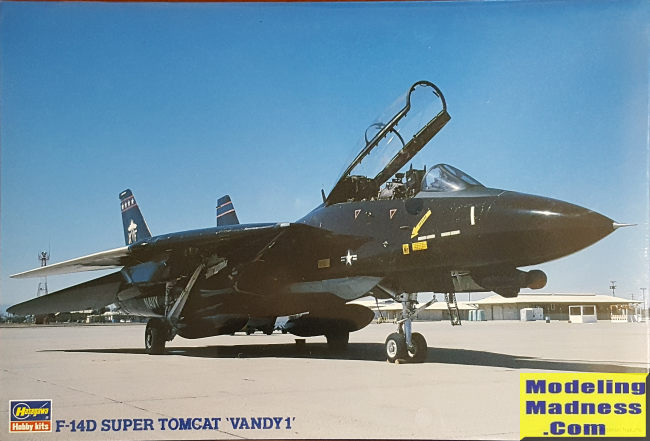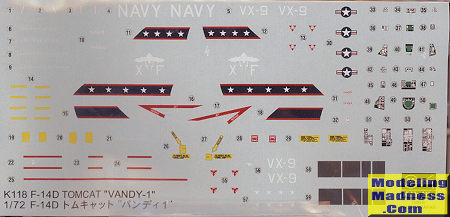
Hasegawa 1/72 F-14D Tomcat ''Vandy 1'
| KIT #: | 04078 (K118) |
| PRICE: | 2200 yen when new |
| DECALS: | One option |
| REVIEWER: | Scott Van Aken |
| NOTES: | 1996 Limited reissue |

| HISTORY |
The final variant of the F-14 was the F-14D Super Tomcat. The F-14D variant was first delivered in 1991. The original TF-30 engines were replaced with GE F110-400 engines, similar to the F-14B. The F-14D also included newer digital avionics systems including a Glass cockpit and replaced the AWG-9 with the newer AN/APG-71 radar. Other systems included the Airborne Self Protection Jammer (ASPJ), Joint Tactical Information Distribution System (JTIDS), SJU-17(V) Naval Aircrew Common Ejection Seats (NACES) and Infrared Search and Track (IRST).
Although the F-14D was to be the definitive version of the Tomcat, not all fleet units received the D variant. In 1989, Secretary of Defense Dick Cheney refused to approve the purchase of any more F-14D model aircraft for $50 million each and pushed for a $25 million modernization of the F-14 fleet instead. Congress decided not to shut production down and funded 55 aircraft as part of a compromise. A total of 37 new aircraft were constructed and 18 F-14A were upgraded to D variants (these were designated as F-14D(R). The R was for rebuild). An upgrade to the F-14D's computer software to allow AIM-120 AMRAAM missile capability was planned but was later terminated.
While upgrades had kept the F-14 competitive with modern fighter aircraft technology, Cheney called the F-14 1960s technology. Despite some aggressive proposals from Grumman for a replacement, Cheney planned to replace the F-14 with a fighter that was not manufactured by Grumman. Cheney called the F-14 a "jobs program", and when the F-14 was canceled, an estimated 80,000 jobs of Grumman employees, subcontractors, or support personnel were affected.
Starting in 2005, some F-14Ds received the ROVER III upgrade and were designated as F-14D(R). Of course, this designation only confused things with the rebuilt aircraft, however, since the system was only used for the F-14s final deployment, the whole thing is really moot.
| THE KIT |
As
demanded, the panel lines are engraved and the kit offers the ability to have
the flaps and slats deployed. In fact, to do it otherwise will require a bit of
surgery to be done on the slat tracks. You can also position the glove vanes
open or closed. Again, some surgery is needed for the closed position. All F-14s
had them wired in the closed position after it was realized that they didn't
really do anything and were an additional maintenance hassle. You also have the ability to have the speed brakes and entrance steps/ladder
open or closed, and two different tails, though one set is not for this
particular boxing. So much has the F-14 been modified and updated over the years
that you really need to have photographs of the aircraft that you are modeling
to get everything right.
A This is an early F-14D boxing from
Hasegawa. This is because it has the Hasegawa F-14D prototype instructions with
an addendum sheet for the production pieces. The nicely molded kit comes in two
bags along with the usual p.e. fret and a single tan resin piece for the
distinctive under-nose seeker carried by this version. In addition it has the
proper gun gas panels and instrument panels typical of the D model along with
the different seats it carried.
This is an early F-14D boxing from
Hasegawa. This is because it has the Hasegawa F-14D prototype instructions with
an addendum sheet for the production pieces. The nicely molded kit comes in two
bags along with the usual p.e. fret and a single tan resin piece for the
distinctive under-nose seeker carried by this version. In addition it has the
proper gun gas panels and instrument panels typical of the D model along with
the different seats it carried.  s required by its price, this kit comes with a small fret of
etched metal. These bits are for the interior, canopy and exhaust. The metalwork
is very well done and should really enhance your Tomcat. For this kit, they
supply the standard F-14A instruction sheet and an addendum sheet that shows the
D model differences The instructions are
very well done as you would expect. They offer color callouts based on Gunze
paint as is the norm with Hasegawa over the last decades.
s required by its price, this kit comes with a small fret of
etched metal. These bits are for the interior, canopy and exhaust. The metalwork
is very well done and should really enhance your Tomcat. For this kit, they
supply the standard F-14A instruction sheet and an addendum sheet that shows the
D model differences The instructions are
very well done as you would expect. They offer color callouts based on Gunze
paint as is the norm with Hasegawa over the last decades.
For markings, we have a single set of markings as shown on the box art. The black F-14 has sold a lot of kits so it is not surprising that Hasegawa boxes it as much as they can. At the time of this kit, VX-4 and VX-5 had combined to create VX-9. The decals are nicely done and you really cannot get an easier to paint scheme.
| CONCLUSIONS |
You can add this one to a growing list of Hasegawa limited reissue kits. I guess it is a good way to do business as they seem to sell rather well. I'm surprised at how well these molds have held up. The final result of the build is a superb model of an important US fighter.
| REFERENCES |
http://en.wikipedia.org/wiki/F-14_Tomcat
August 2023
Thanks to me for this one, eh?
Copyright ModelingMadness.com. All rights reserved. No reproduction in part or in whole without express permission from the editor.
If you would like your product reviewed fairly and quickly, please contact me or see other details in the Note to Contributors.